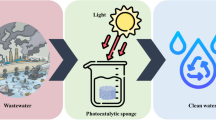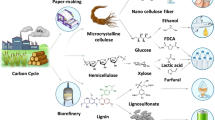Abstract
Ozone treatment is a common way to functionalize commercial multi-walled carbon nanotubes (CNTs) with various oxygen functionalities like carboxyl, phenol and lactone groups, in order to enhance their textural properties and chemical activity. In order to detail the effect of each functional group, we correlated the activity with the surface density of each group, and found that the carboxyl groups play a pivotal role in two important catalytic reactions, namely the electrochemical oxygen reduction reaction (ORR) and agar conversion to 5-hydroxymethylfurfural (HMF). During the processes, the hydrophilic surface provides a strong affinity for reaction substrates while the improved porosity allows the efficient diffusion of reactants and products. Furthermore, the activity of functionalized CNTs for agar conversion remained almost unchanged during nine cycles of reaction. This work highlights a strategy for improving the activity of CNTs for electrochemical ORR and agar conversion reactions, as well a promising application of carboxyl-rich CNTs as a solid acid catalyst to produce high-purity HMF—an important chemical intermediate.

Similar content being viewed by others
References
Iijima, S. Helical microtubules of graphitic carbon. Nature 1991, 354, 56–58.
Oberlin, A.; Endo, M.; Koyama, T. Filamentous growth of carbon through benzene decomposition. J. Cryst. Growth 1976, 32, 335–349.
Baughman, R. H.; Zakhidov, A. A.; de Heer, W. A. Carbon nanotubes—the route toward applications. Science 2002, 297, 787–792.
Zhang, J.; Liu, X.; Blume, R.; Zhang, A. H.; Schlögl, R.; Su, D. S. Surface-modified carbon nanotubes catalyze oxidative dehydrogenation of n-Butane. Science 2008, 322, 73–77.
Aguilar, C.; García, R.; Soto-Garrido, G.; Arriagada, R. Catalytic wet air oxidation of aqueous ammonia with activated carbon. Appl. Catal. B 2003, 46, 229–237.
Yang, S. X.; Li, X.; Zhu, W. P.; Wang, J. B.; Descorme, C. Catalytic activity, stability and structure of multi-walled carbon nanotubes in the wet air oxidation of phenol. Carbon 2008, 46, 445–452.
Yeager, E. Dioxygen electrocatalysis: mechanisms in relation to catalyst structure. J. Mol. Catal. 1986, 38, 5–25.
Hossain, M. S.; Tryk, D.; Yeager, E. The electrochemistry of graphite and modified graphite surfaces: the reduction of O2. Electrochim. Acta 1989, 34, 1733–1737.
Sarapuu, A.; Vaik, K.; Schiffrin, D. J.; Tammeveski, K. Electrochemical reduction of oxygen on anthraquinone-modified glassy carbon electrodes in alkaline solution. J. Electroanal. Chem. 2003, 541, 23–29.
Vaik, K.; Sarapuu, A.; Tammeveski, K.; Mirkhalaf, F.; Schiffrin, D. J. Oxygen reduction on phenanthrenequinone-modified glassy carbon electrodes in 0.1 M KOH. J. Electroanal. Chem. 2004, 564, 159–166.
Wang, L.; Zhang, J.; Zhu, L. F.; Meng, X. J.; Xiao, F. S. Efficient conversion of fructose to 5-hydroxymethylfurfural over sulfated porous carbon catalyst. J. Energy Chem. 2013, 22, 241–244.
Liu, R. L.; Chen, J. Z.; Huang, X.; Chen, L. M.; Ma, L. L.; Li, X. J. Conversion of fructose into 5-hydroxymethylfurfural and alkyl levulinates catalyzed by sulfonic acid-functionalized carbon materials. Green Chem. 2013, 15, 2895–2903.
Qi, X. H.; Guo, H. X.; Li, L. Y.; Smith, R. L. Acid-catalyzed dehydration of fructose into 5-hydroxymethylfurfural by cellulose-derived amorphous carbon. ChemSusChem 2012, 5, 2215–2220.
Goertzen, S. L.; Thériault, K. D.; Oickle, A. M.; Tarasuk, A. C.; Andreas, H. A. Standardization of the Boehm titration. part I. CO2 expulsion and endpoint determination. Carbon 2010, 48, 1252–1261.
Oickle, A. M.; Goertzen, S. L.; Hopper, K. R.; Abdalla, Y. O.; Andreas, H. A. Standardization of the Boehm titration: Part II. method of agitation, effect of filtering and dilute titrant. Carbon 2010, 48, 3313–3322.
Najafi, E.; Kim, J. Y.; Han, S. H.; Shin, K. UV-ozone treatment of multi-walled carbon nanotubes for enhanced organic solvent dispersion. Colloids Surf. A 2006, 284, 373–378.
Wang, D. W.; Su, D. S. Heterogeneous nanocarbon materials for oxygen reduction reaction. Energy Environ. Sci. 2014, 7, 576–591.
Álvarez, P. M.; García-Araya, J. F.; Beltrán, F. J.; Masa, F. J.; Medina, F. Ozonation of activated carbons: Effect on the adsorption of selected phenolic compounds from aqueous solutions. J. Colloid Interface Sci. 2005, 283, 503–512.
Razumovskii, S. D.; Gorshenev, V. N.; Kovarskii, A. L.; Kuznetsov, A. M.; Shchegolikhin, A. N. Carbon nanostructure reactivity: Reactions of graphite powders with ozone. Fullerenes, Nanotubes, Carbon Nanostruct. 2007, 15, 53–63.
Chiang, H. L.; Huang, C. P.; Chiang, P. C. The surface characteristics of activated carbon as affected by ozone and alkaline treatment. Chemosphere 2002, 47, 257–265.
Li, F. X.; Wang, Y.; Wang, D. Z.; Wei, F. Characterization of single-wall carbon nanotubes by N2 adsorption. Carbon 2004, 42, 2375–2383.
Gong, K. P.; Du, F.; Xia, Z. H.; Durstock, M.; Dai, L. M. Nitrogen-doped carbon nanotube arrays with high electrocatalytic activity for oxygen reduction. Science 2009, 323, 760–764.
Liu, J.; Li, S. G.; Liao, W. B.; Chen, Y. A new europium(III) complex containing a neutral ligand of 2-(pyridin-2-yl)-1H-benzo[d]imidazole: Thermal, electrochemical, luminescent properties. Spectrochim. Acta, Part A 2013, 107, 102–107.
Jeon, I.Y.; Choi, H. J.; Jung, S. M.; Seo, J. M.; Kim, M. J.; Dai, L. M.; Baek, J. B. Large-scale production of edge-selectively functionalized graphene nanoplatelets via ball milling and their use as metal-free electrocatalysts for oxygen reduction reaction. J. Am. Chem. Soc. 2012, 135, 1386–1393.
Liu, Z. Y.; Zhang, G. X.; Lu, Z. Y.; Jin, X.Y.; Chang, Z.; Sun, X. M. One-step scalable preparation of N-doped nanoporous carbon as a high-performance electrocatalyst for the oxygen reduction reaction. Nano Res. 2013, 6, 293–301.
Fu, G. T.; Liu, Z. Y.; Chen, Y.; Lin, J.; Tang, Y. W.; Lu, T. H. Synthesis and electrocatalytic activity of Au@Pd core-shell nanothorns for the oxygen reduction reaction. Nano Res. 2014, 7, 1205–1214.
Neumann, C. M.; Laborda, E.; Tschulik, K.; Ward, K.; Compton, R. Performance of silver nanoparticles in the catalysis of the oxygen reduction reaction in neutral media: Efficiency limitation due to hydrogen peroxide escape. Nano Res. 2013, 6, 511–524.
Si, W. F.; Li, J.; Li, H. Q.; Li, S. S.; Yin, J.; Xu, H.; Guo, X. W.; Zhang, T.; Song, Y. J. Light-controlled synthesis of uniform platinum nanodendrites with markedly enhanced electrocatalytic activity. Nano Res. 2013, 6, 720–725.
Zheng, F. L.; Wong, W. T.; Yung, K. F. Facile design of Au@Pt core-shell nanostructures: Formation of Pt submonolayers with tunable coverage and their applications in electrocatalysis. Nano Res. 2014, 7, 410–417.
Birry, L.; Zagal, J. H.; Dodelet, J. P. Does CO poison Fe-based catalysts for ORR? Electrochem. Commun. 2010, 12, 628–631.
Author information
Authors and Affiliations
Corresponding authors
Electronic supplementary material
Rights and permissions
About this article
Cite this article
Zhang, Y., Chen, C., Peng, L. et al. Carboxyl groups trigger the activity of carbon nanotube catalysts for the oxygen reduction reaction and agar conversion. Nano Res. 8, 502–511 (2015). https://doi.org/10.1007/s12274-014-0660-3
Received:
Revised:
Accepted:
Published:
Issue Date:
DOI: https://doi.org/10.1007/s12274-014-0660-3




